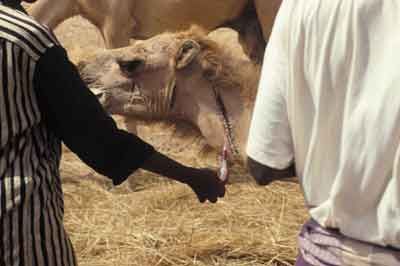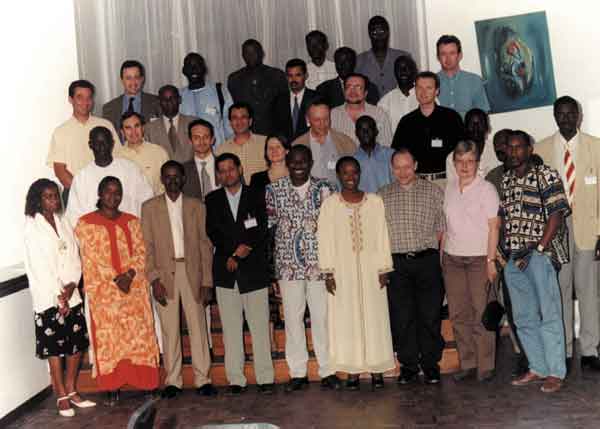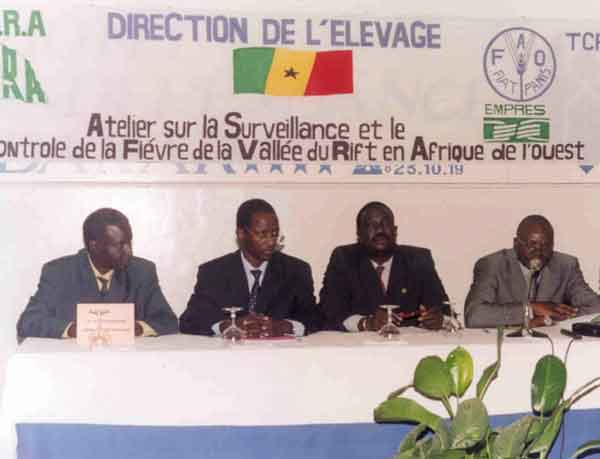FAO/UNDP Expert Consultation on Risk Assessment and Risk Reduction of RVF Transmission in Trade Exchanges between the Horn of Africa and the Arabian Peninsula, Rome, 15-16 May 2001
In 1997-1998 excessive rainfall associated with the El Niño/Southern Oscillation phenomena precipitated a severe epizootic of RVF in the Horn of Africa. This caused much human and livestock disease and led to many countries, including those in the Arabian Peninsula, placing a total ban on trade in ruminants from the Horn of Africa. This and other recent episodes of this disease in Africa have resulted in FAO being asked by member countries and other authorities to address the issues created by RVF.

Trade of livestock between the Horn of Africa and the Arabian peninsula (Port of Berbera, Northern Somalia)
PHOTO COURTESY OF MARC BLEICH
FAO and UNDP held an expert consultation at FAO headquarters, Rome on 15 and 16 May 2001. Six international experts on RVF plus invited observers discussed issues directed to improving the management of the risk to humans and livestock that is posed by RVF. The main objective of the meeting was to develop guidelines to reduce the risk of RVF transmission from animals to humans and between animal populations.
The natural history of RVF and its potential distribution inside and outside of Africa today were reviewed and discussed. The techniques available for assessing the risk of RVF, including the recent innovative early warning techniques using satellite imagery and ground-truth surveillance systems using mosquito population biology, sentinel herds and serology, were appraised. The meeting then discussed how these and other techniques, such as vaccination, could be used to reduce the risk of disease.
An understanding of the basic cycle of epizootics of disease, followed by long interepizootic periods, was recognized as essential to any risk management. The epizootics are associated with excessive rainfall, flooding, emergence of the infected mosquito vectors in high numbers, and high transmission rates among livestock and humans. Conversely, during interepizootic periods, the levels of infection are usually so low as to be undetectable. There is no recognizable disease in humans or in animals and intensive surveillance techniques may be necessary to detect any evidence of virus activity. A fundamental aspect of the natural history of RVF that was emphasized throughout the meeting is that RVF is widespread throughout Africa and that countries where evidence of the virus has been confirmed in the past are likely to be permanently infected. Recovered animals and animals vaccinated at least one month earlier are not infectious, are safe to eat and can be safely traded.
The expert consensus was that during epizootics, the risk of transmission of RVF virus through infected animals or humans is significant and warrants stringent measures to prevent transmission. However, in the interepizootic periods the risk of RVF is low, and would become significantly lower if risk reduction techniques were applied.
The meeting identified three epidemiological situations - epizootic, pre-epizootic and interepizootic. It recommended strategies that could be adopted by importing and exporting countries to reduce the risk of virus transmission in each of these situations. These strategies include the optional use of vaccine.
The meeting identified specific issues requiring future research and development, in particular new vaccines and epidemiological studies. Suitable laboratory tests for the diagnosis of RVF are available. It also identified the need to amend the International Office of Epizootics (OIE) Code for RVF in order to reflect current scientific knowledge about this disease and make it more applicable to all circumstances.
The principal recommended strategies for reducing the risk of transmission of RVF in trade livestock are summarized below:
LEVEL OF RISK |
ACTIVITY IN EXPORTING COUNTRY |
ACTIVITY IN IMPORTING COUNTRY |
HIGH |
Define extent of infection |
Cease all imports of livestock from affected regions |
Epizotic RVF |
Longitudinal monitoring of infection in livestock populations (i.e. clinical surveillance, virus isolation/IgM antibodies) Determine the point at which virus activity has returned to pre-epizootic levels Cease all imports of livestock from affected regions |
Resume trade 3-6 months after the last evidence of infection OR When the country considers the high risk has disappeared |
POTENTIALLY HIGH Pre-epizootic conditions identified |
Increase the level of monitoring in known RVF epizootic areas, such as floodplains, by clinical surveillance for abortion in livestock, disease in humans and serology in livestock Consider vaccination of trade stock at least one month before movement |
Increase vigilance at ports of entry Increase random sampling at ports for evidence of recent infection (IgM antibody in the absence of a history of vaccination) If vaccinated animals are to be accepted they should be randomly sampled at ports for IgG antibodies |
LOW Interepizootic period |
Monitor sentinel herds in high-risk areas (floodplains) Consider vaccination of all trade animals at 9-12 months age |
Regular random sampling of trade animals for IgM antibodies |
Follow-up workshop on RVF transmission and trade, Nairobi, 21-22 June 2001
The meeting endorsed the recommendations of the expert consultation and also asked FAO and OAU-IBAR to pursue the establishment of a forum for exchange of dialogue between importers and exporters of livestock and to facilitate a revision of the OIE Code for RVF.
This meeting was a direct follow-up to the earlier expert consultation held in Rome on 15 and 16 May. Its purpose was to promote and explain the recommendations of the expert meeting to the main players in the Horn of Africa including chief veterinary officers (CVOs) and other interested international bodies, and some observers from livestock importing countries. It was hoped that the meeting would endorse the recommendations of the expert consultation, and advise how best these could be implemented in the Horn today.

Testing camels for brucellosis before export (Somalia)
PHOTO COURTESY OF MARC BLEICH
There was official representation at CVO or director-general level from Eritrea, Kenya, Somalia (Mogadishu), Somaliland, the Sudan, the United Republic of Tanzania, Uganda and Yemen plus senior epidemiologists or field staff from Egypt, Ethiopia, Djibouti and Yemen. International organizations represented included the Organization of African Unity/Interafrican Burau for Animal Resources (OAU/IBAR), UNDP Somalia, the UN Office for the Coordination of Humanitarian Affairs (OCHA), the FAO Special Relief Operations Service (TCOR), the Intergovernmental Authority on Development (IGAD), the European Union-Somalia, the United States Agency for International Development (USAID), the Pan African Campaign against Epizootics (PACE) and the Community Animal Health and Participatory Epidemiology (CAPE) project, plus several non-governmental organizations actively involved in Somalia. In addition, representatives from the private livestock trade sector were also present. International expertise on RVF was provided by Drs Glyn Davies, Pamela Hunter and Bob Swanepoel.
The meeting endorsed the recommendations of the expert consultation and also asked FAO and OAU-IBAR to pursue the establishment of a forum for exchange of dialogue between importers and exporters of livestock and to facilitate a revision of the OIE Code for RVF. The national reports presented not only indicate how widespread RVF is in the Horn, but also show that a number of countries fall short of the full and transparent reporting of the disease that is envisaged will be necessary for future trade. Another complication is that representatives from some countries apparently still fail to understand the epidemiology of RVF, especially the distinction between infection and disease.
The meeting was a successful step in the process of establishing dialogue leading to improved livestock trade regulations between the Horn and the Arabian Peninsula. Whilst vaccination was seen as a useful technique for reducing risk, questions were raised about how effectively this could be implemented in the parts of the Horn from where the sheep and other livestock emanate. The next steps under the FAO project SOM/01/04/01/12 will be to take the results and recommendations from both the expert cpnsulation and the technical workshop to the importers and initiate a dialogue between the parties concerned.
Workshop on RVF surveillance and control in West Africa, Dakar, 9-12 April 2001
Although surveillance has been considerably improved, safe and efficient tools for disease control are still lacking. More studies on the biology of the vector are needed to define an appropriate vector control strategy.
A workshop on RVF surveillance and control was held in Dakar to gather the different institutions and stakeholders involved in the monitoring of the disease in the region. The workshop was part of the activities organized under the aegis of the FAO/TCP project TCP/RAF/8931 that last year initiated a regional early warning system in Mali, Mauritania and Senegal (see details in EMPRES Bulletin No. 15).
A panel of national and international experts met to discuss the progress made in the surveillance and control of the disease in the subregion, critically assess the early warning system that had been implemented and define the strategy to be adopted in the future at regional level. Forty participants represented the national veterinary services and central laboratories, national and international research centres (Institut de recherche pour le développement, Institut Pasteur of Dakar and Paris), international organizations (OIE, World Health Organization [WHO] and FAO) and donors.

Workshop participants
PHOTO COURTESY OF VINCENT MARTIN, EMPRES
Through the strong commitment of national institutions, the surveillance of RVF has been improved over the past two years, as has the understanding of the epidemiology of the disease in the three countries. After the end of the TCP project in September 2001, RVF surveillance will continue as part of the national disease surveillance system. Furthermore, the sustainability of the surveillance system implemented so far will be ensured by a project of "telemedecine" called EMERCASE that aims to develop models of RVF spread in Senegal and foster real-time communication of disease occurrence via satellite connection. PACE will also play a major role in the surveillance of African epizootics such as RVF.

Official speakers at the opening session
PHOTO COURTESY OF VINCENT MARTIN, EMPRES
Although surveillance has been considerably improved, safe and efficient tools for disease control are still lacking. More studies on the biology of the vector are needed to define an appropriate vector control strategy.
The first results of a vaccine trial initiated in the context of the project were also presented during the workshop. The strain used was developed by the Institut Pasteur of Paris (Dr Bouloy) and a preliminary trial on small ruminants was carried out at the Laboratoire national d'études et de recherches vétérinaires (LNERV) in Dakar. The first results are encouraging and it was agreed by the participants that the strain R 566 could be a good vaccine candidate for emergency control of the disease.
An interdisciplinary approach was also recognized as the only way forward to combat the disease. The forum provided by the workshop enabled participants with different backgrounds to meet and exchange experiences. The full proceedings of the meeting will soon be available in French on the FAO-EMPRES Web site.